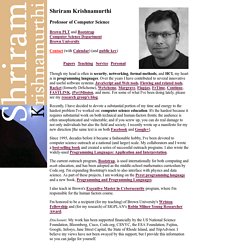Zoom
Trash

The Art of Computer Programming. By Donald E.

Knuth. Click here to sign up for The Art of Computer Programming Newsletter, which features updates on new editions and promotions. (photo of TAOCP, 1968–2015, by Héctor García-Molina) At the end of 1999, these books were named among the best twelve physical-science monographs of the century by American Scientist, along with: Dirac on quantum mechanics, Einstein on relativity, Mandelbrot on fractals, Pauling on the chemical bond, Russell and Whitehead on foundations of mathematics, von Neumann and Morgenstern on game theory, Wiener on cybernetics, Woodward and Hoffmann on orbital symmetry, Feynman on quantum electrodynamics, Smith on the search for structure, and Einstein's collected papers. Wow! View “historic” publisher's brochure from the first edition of Volume 1 (1968) eBook versions These volumes are now available also in portable electronic form, using PDF format prepared by the experts at Mathematical Sciences Publishers.
Volume 1 Volume 2 Volume 3 Volume 4A 7.2.2. Volume 5. Research centers. Research teams and centers : Europe - North America - Other Publications - Blogs - Organizations and conferences - Mailing lists - Software - Other Here is a list of research groups and departments (and some isolated logics specialists in other departments) in the foundations of mathematics and computer science (logic, set theory, model theory, theoretical computer science, proof theory, programming languages).

Created by Sylvain Poirier, author of this site of introduction to set theory and foundations of mathematics and physics, in July 2012 (see note). Europe. Tutorials, Programs, Code Examples, Questions and Answers, MCQs for IT Students and Professionals. History of Computer Communications 1968 -1988. Home - CHM. Oral History Collection. Www.Visual6502.org. Category:Formal methods. MODNET. MODNET is an FP6 Marie Curie Research Training Network in Model Theory and its Applications, funded by the European Commission under contract number MRTN-CT-2004-512234 (MODNET).

It will run from 1 January 2005 to 31 December 2008. This project is designed to promote training and research in model theory, a part of mathematical logic dealing with abstract structures (models), historically with connections to other areas of mathematics. Formal Methods Wiki. Formal methods are mathematical techniques for developing computer-based software and hardware systems.

Please update this page or add a new page if you know of relevant online information not included here or would like to maintain information on a particular topic. Use the comp.specification.misc newsgroup, for general formal methods queries. Please link to if you create a permanent hyperlink to this website. In case of problems, please contact Jonathan Bowen. Introduction This document contains some pointers to information on Formal Methods↑, useful for mathematically describing and reasoning about computer-based systems, available around the world on the World Wide Web (WWW). Indicates new entries. indicates a (subjectively!) Selected resources This space will be used to indicate selected new entries and developments in these formal methods pages. MODEL THEORY GROUP. The Digital Culture and Communication section of ECREA. Reviews and Top Software at Capterra. Home.
Shriram Krishnamurthi. Though my head is often in security, networking, formal methods, and HCI, my heart is in programming languages.

Over the years I have contributed to several innovative and useful software systems: JavaScript and Web tools, Flowlog and related tools, Racket (formerly DrScheme), WeScheme, Margrave, Flapjax, FrTime, Continue, FASTLINK, (Per)Mission, and more. For some of what I've been doing lately, please see my research group's blog. Recently, I have decided to devote a substantial portion of my time and energy to the hardest problem I've worked on: computer science education.
It's the hardest because it requires substantial work on both technical and human-factors fronts; the audience is often unsophisticated and vulnerable; and if you screw up, you can do real damage to not only individuals but also the field and society. I recently wrote up a manifesto for my new direction [the same text is on both Facebook and Google+]. AI memories — expert systems.
December 3, 2015 This is part of a four post series spanning two blogs.

As I mentioned in my quick AI history overview, I was pretty involved with AI vendors in the 1980s. Here on some notes on what was going on then, specifically in what seemed to be the hottest area at the time — expert systems. Summing up: The expert systems business never grew to be very large, but it garnered undue attention (including from me).
First, some basics. The core expert system metaphor was: Facts in.A question (often implicit) in.A recommended decision out.The essential technology of expert systems was what we’d now call a “rules engine”, but then was often called an “expert systems shell” or “inference engine”.The development process consisted of “knowledge engineers” talking to human experts and coming up with rules.Any product could handle 10s of rules. Anyhow: All combined, the expert system vendors didn’t accomplish much. Teknowledge was basically the company that commercialized EMYCIN. Recursion. Structure and Interpretation of Computer Programs.